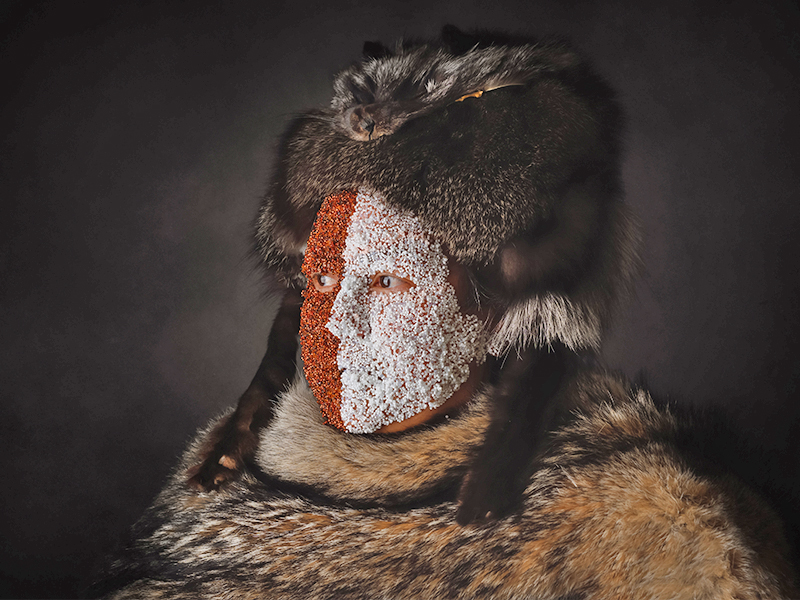Celebrating the Month of the Artist
Calgary Arts Development celebrates our city's creative community this September 2023
September has been proclaimed the Month of the Artist in Alberta — a month dedicated to celebrating artists and the value they bring to the province, both socially and economically. In recognition of Calgary’s artists and arts organizations, this month we are sharing the stories featured in our recent Accountability + Impact Report. You’ll find a new story here every weekday from September 5 – 29, 2023 — scroll down to see previous posts.
Today’s Featured Artist: Alberta Craft Council
Since 1980, the Alberta Craft Council (ACC) has been supporting contemporary and heritage crafts as significant art forms that contribute to Alberta’s culture. Part of the ACC’s mission is to support and develop a craft sector of creative, skilled, viable and sustainable craftspeople, studios, businesses and networks. Executive Director Jenna Stanton has been with the ACC for 20 years. “Support from Calgary Arts Development (CADA), by way of operating grants and other funding, has been essential to our success in mission and vision and growing our community in Calgary.”
Based in Edmonton and Calgary, the ACC organizes between 15 to 20 exhibits a year; alongside their social enterprise retail galleries, as well as offering craft artists professional development opportunities, and one-on-one support. In 2017, ACC opened a second location in Calgary, to better serve its membership: with 50% of their artist members located in the greater Calgary area, it was important to the ACC to have a permanent physical presence there.
In 2022, with new investment from CADA, the ACC was able to significantly increase its programing with monthly craft tours, hands on workshops, cKids camps in collaboration with our cultural hub neighbours at cSpace, along with free Make and Take events at cSpace. They also were able to pay artists to deliver this exciting hands-on programming. It has also helped create awareness and unique creative experiences for the public to connect directly with artists and contemporary craft culture.
The funding received from CADA for ACC’s 2021/22 fiscal year helped fund several public-facing exhibits, including: Alberta Craft Excellence celebrating ACC’s 40th anniversary, Democracy of Jewellery, and Coming Up Next: A National Emerging Craft Exhibition.
“Our 40th anniversary exhibit was a celebration of excellence in contemporary and traditional Alberta fine craft,” explains Stanton. “Members from across the province were invited to apply. Final selections were made by our jury: Natali Rodrigues, associate professor at Alberta University of the Arts (AU Arts); Sharon Rose Kootenay, a Metis artist from Treaty 6 and founding member of the Aboriginal Arts Council of Alberta; and finally, Professor Emerita of Art and Craft Histories at AU Arts, Jennifer Salahub.”
Democracy of Jewellery was curated by Canmore member Kari Woo. “This exhibit explored how accessibility to materials is being affected by generalization and globalization of the marketplace and how that, in turn, impacts independent craft makers, particularly those making handmade jewellery.” Participating artists included: Sarah Alford, Devon Clark, Jamie Kroeger, Louise Perron and Lyndsay Rice.
“Coming Up Next is an important biennial exhibition,” says Stanton. “It celebrates the creativity, innovation and skill of emerging, Canadian craft artists. The exhibition in 2022 featured 14 artists who participated in a physical exhibit and an on-line discussion about their craft. This exhibition also helps emerging artists connect with peers, mentors, collectors, and helps them build confidence.”
In her decades with ACC, Stanton has seen a resurgence of interest among people looking to connect to their creativity, especially during these past pandemic years. “The funding from CADA is helping us to connect with these new communities of makers and help them connect with the broader Alberta craft community, which ultimately helps everyone grow.”
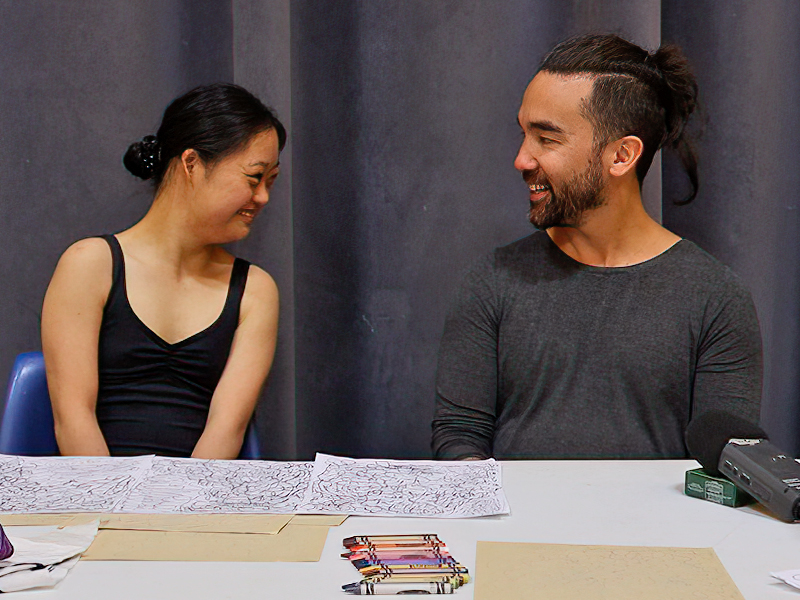
Meg Ohsada, a second-generation Japanese Canadian living in Alberta, began her journey as a dancer and figure skater in elementary school. Her family immediately saw her gift and talent for communicating through dance. Meg has down syndrome (also known as trisomy 21), which means she experiences challenges when it comes to verbal communication. Discovering her ability to translate her emotions into movement has allowed her to communicate, release emotions and frustrations, and develop her natural talent for choreography and creative expression.
Meg, now 28, is more focused than ever on developing her artistic practice and exploring new ways to communicate and to grow her confidence as a performer through dance and choreography. “When I saw Kunji Ikeda and his work — I loved it! He is not only a great dancer but also has experience working with artists who have disabilities. It was a perfect match and perfect timing! Calgary Arts Development (CADA) ArtShare funding allowed me to afford one-on-one sessions with Ikeda and this helped me to better evaluate my current skills and potential. What I’ve learned during my time with him has helped me perform in public and has allowed people to see me enjoying dancing. I hope those opportunities can inspire diversity and inclusion for dancers with disabilities in the arts and dance sectors.”
Working with Ikeda has helped Meg feel more confident to move in new, authentic ways: “He helped me realize that I didn’t need to be someone else — I can be me.” Ikeda has helped Ohsada find new opportunities to share her gift. Last September, she travelled to Victoria to perform with Ikeda and other dancers, and most recently has begun working with the National accessArts Centre (NaAC), in Calgary. This work is part of the New Work, New Ways program at NaAC, which is also supported by funding from CADA along with other funding partners.
In this project, Meg is in three of seven participating ensembles: Musical Theatre, Dance, and Indigenous Ways of Knowing. In these ensembles they are doing everything from scene development, script writing, costume design, set design, songwriting, quilting and, of course, dance and choreography. They will present their new works in an open-studio style setting (about 50 individual artists altogether) and live performances on the evening of May 25, 2023 at The GRAND, downtown Calgary.
Meg’s ability to grow and develop as an artist and choreographer wouldn’t be possible without access to the ArtShare funding from CADA. This funding gives artists, like Meg, the opportunity to work with mentors who understand and speak the same artistic language. Meg’s mom, Noriko, also commends CADA for offering support throughout the entire grant process — from writing the application, to completing the final report, it is helpful for artists with disabilities who may need extra support and time.
“I don’t often meet people like me in the mainstream dance scene,” says Meg. “I would like to be seen and have more opportunities to connect with performing arts networks in Alberta and Calgary, and to collaborate with more artists in the future.”
YouTube video of Meg and Kunji sessions
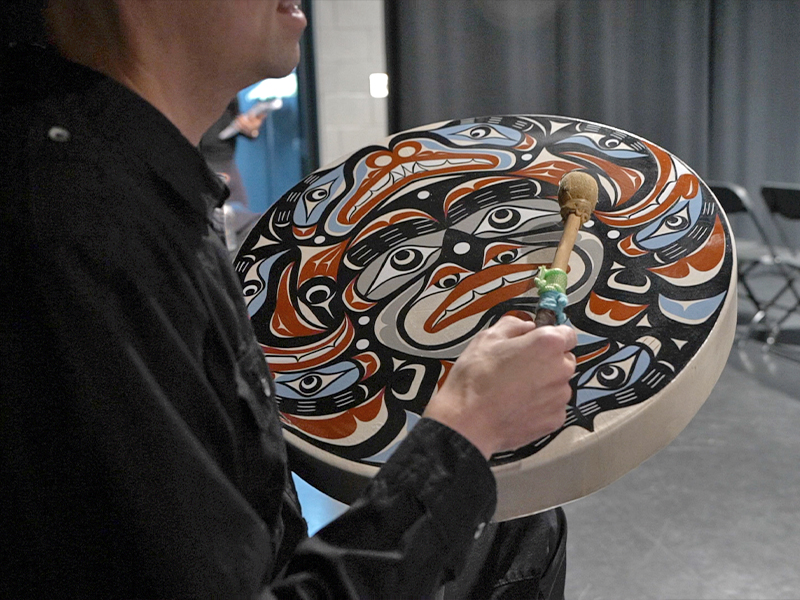
Robert Hunter, a Cree artist originally from Peepeekisis Cree Nation in southern Saskatchewan, was struggling with feelings of isolation and not belonging during the pandemic.
“I was thinking about a lot of spaces where I felt I didn’t belong, or about spaces where there is a perceived feeling of not belonging. I wanted to make a statement about what artmaking is and step into what I perceived to be a high or elite form of art — like opera, where traditionally someone like me didn’t belong.”
“It started with this long-held vision I had of kokum (grandmother in Cree) singing opera as she makes bannock. She calls to her grandkids, one of whom is my grandmother, to come and sit and eat with her by the fire. Each of the grandkids attends residential school and is home for the summer.” Hunter followed his vision and ended up with a libretto that was inspired by his personal family history but was also intertwined with the greater story of First Nations on this land and the impact of the residential schools on their culture, their families and living in Truth and Reconciliation generations later.
“As far as I could tell, there weren’t any operas written in Cree and only a handful of Indigenous opera singers — none of whom knew the language. So, I decided that I was going to mingle Indigenous music and language with opera and see what might emerge.”
What emerged was Miyo-âcimowin (Good Story) — Indigenous drumming, singing, classical piano and organ music woven together with Indigenous storytelling, theatre and opera. Good Story features Calgary-based performers Jeanine Williams (mezzo-soprano), Lauren Woods (soprano), Adam Brousseau (bass-baritone) and Ethan Hill (pianist, organist). Hunter, in the same way that he played with the idea of making an opera that went against the traditions of opera, went against what most people might have expected and invited non-Indigenous performers to perform in Cree. “Most importantly, I began to see this project as a unique opportunity to have non-Indigenous artists performing in an Indigenous language and to have this project align with Call to Action #83 (from the Truth and Reconciliation Commission): collaborative work between Indigenous and non-Indigenous artists in commemoration of the Residential Schools.
Hunter acknowledges that without receiving a project grant from Calgary Arts Development (CADA) he never would’ve been able to bring this opera to the stage. “The support of CADA from application to the live production of Good Story, and including opportunities to widen my social and professional network through the community that CADA has built has been incredible for me and my family. Good Story has given us a sense of pride about our story. For me as an artist, it has opened new doors and opportunities for collaboration. It was also incredibly validating for me, someone who has had challenges in finding their place, their sense of belonging in the arts community, to know that CADA had faith in my work and in me as an artist.”
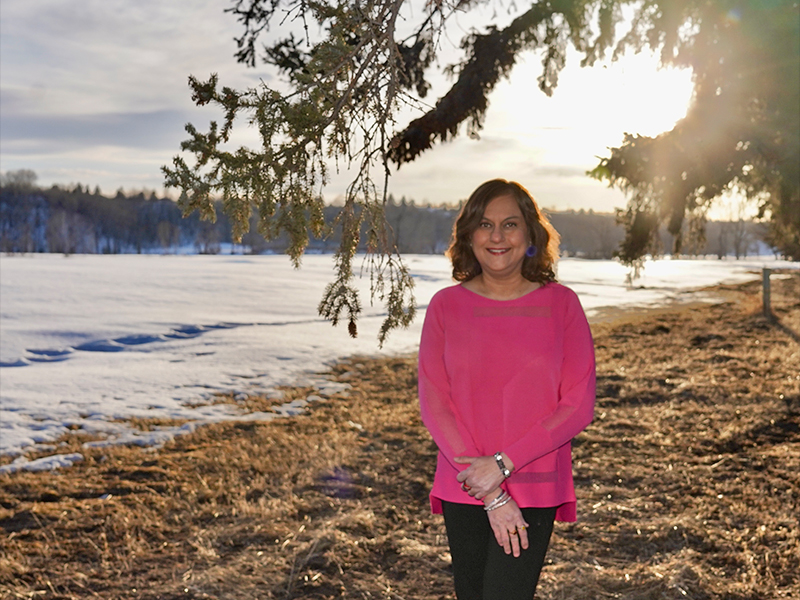
For emerging Calgary writer Kelly Kaur, travelling to Bali was a pivotal experience as a newly published novelist. In October 2022, Kelly Kaur’s first novel, Letters to Singapore (Stonehouse Publishing, 2022) made its first international launch (previously launched in Canada) at the Writers and Readers Festival in Ubud, Bali — an annual international festival that features world-renowned writers and thinkers such as Fatima Bhutto, Hanya Yanagihara, Teju Cole, and now, Kelly Kaur: “To be able to engage with an international group of peers and readers allowed me not only to share my experiences and challenges as a writer and help others on a similar path as me to learn, but also contributed to my growth as a writer.”
Letters to Singapore borrows from Kaur’s firsthand experiences as a woman uprooting her life in Singapore and moving to Calgary to study at the University of Calgary in the ’80s and ’90s. The novel explores the main character’s experiences of being an immigrant, a student and a woman finding her identity. Just as the experiences of the women in Kaur’s novel are universal and echo the experiences of many women around the world, Kaur also discovered while attending the festival that many of her experiences and challenges as an emerging writer were also common with other writers. “Having the success of my launch and presentation at the festival has helped me become more comfortable and self-assured in sharing my journey as a writer and being able to support communities of writers around the world.”
“Before, I often didn’t have the courage to apply for arts funding because I lacked confidence. Receiving funding from CADA gave me a sense of confidence and credibility that has both metaphorically and literally expanded my world as a writer.” After returning from the festival, Kaur has felt her drive to write increase and has had a number of pieces accepted for publication in upcoming international anthologies, including two poems on human rights that have been accepted into a travelling exhibit that is part of the 2023 International Human Rights Art Festival (North Dakota, USA), and also three poems and two non-fiction pieces that will be featured in upcoming international and Canadian anthologies.
Kaur has also recently been shortlisted as one of 75 immigrants from across the country for Western Union’s 15th Annual Top 25 Immigrant Awards. “This is all because of my writing journey, and I am feeling very emotional and grateful. The validation I felt being accepted for the Calgary Arts Development (CADA) micro-grant program said to me that not only was I being seen, but that I bring value to the Alberta and Calgary arts community.”
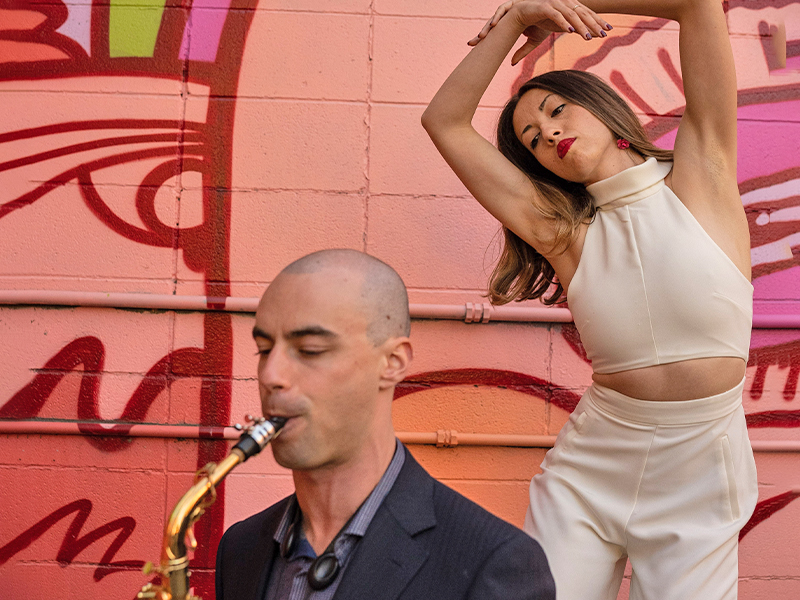
Saxophonist-composer Daniel Pelton and dance artist Jocelyn Mah met in 2020 and connected immediately over their shared commitment to the music-dance relationship, which led to some playful, artistically satisfying, and collaborative interactions.
They soon realized they wanted to actively pursue their professional artistic partnership. Since 2020 they’ve been involved with several projects together, including Synergy Set: A Music-Movement Cabaret as part of Fluid Fest 2021, a children’s workshop for the Calgary Philharmonic Orchestra’s PhilKids Program, and most recently, The Secancy Project, supported by Calgary Arts Development (CADA).
“For me as a classically trained dance artist, it’s easy to get stuck, creatively, in that one lane — to become insular. I wanted to open my eyes and learn more from other artists working in other mediums.” Born and raised in Calgary, Jocelyn Mah is a graduate of The School of Toronto Dance Theatre and holds her Master of Arts in Contemporary Dance Performance from The London Contemporary Dance School (London, UK). Jocelyn has performed for numerous independent artists and companies based in Toronto, Calgary, Edmonton and London (UK).
Daniel Pelton has been playing saxophone since he was nine. Graduating in 2018 from the University of Calgary, he studied under award-winning musicians including Juno Award-winner Allan Gordon Bell. Daniel’s training has made him a versatile performer in classical, jazz and contemporary music styles. Daniel’s acclaimed horn band Long Time No Time has shared the stage with notable acts, including New York’s Too Many Zooz. As the Calgary Public Library’s Composer in Residence for 2020, Daniel focused on creating an environment for all community members to connect through music.
“Funding for the project was essential and allowed us to plan, create, perform and produce a 4.5-minute film of our collaboration,” explains Jocelyn. “We hired videographer Gbohunmi and Recording Engineer Jess Oliverio who helped bring the project to life.” Jocelyn and Daniel both felt a powerful sense of community interwoven into the production of The Secancy Project.
“Starting with videographer Gbohunmi, who gave us a whole new lens (pardon the pun) through which we could view our art and what that might mean to different communities. At our rehearsal location, Decidedly Jazz Danceworks (DJD), we had space to immerse ourselves in our practice, but also, we were able to connect with and receive creative insights, feedback and inspiration from the community of artists also using DJD studio space. And finally, cSPACE offered us a unique location to film our project — their new Eau Claire Neighbourhood Hub — free of charge, and thus including another arm of the Calgary arts community.”
“The Secancy Project is about the intersection of dance and music. Thanks to CADA we were able to explore and deepen our understanding of the relationship between our own artistic practices, and of each other’s in relation to music and movement. Our creative collaboration is about being active participants in the other’s medium. Our hope is for this performance to inspire others to deepen their collaborative spirit and explore ways in which that creative spirit can be shared by artists in music and movement communities.”
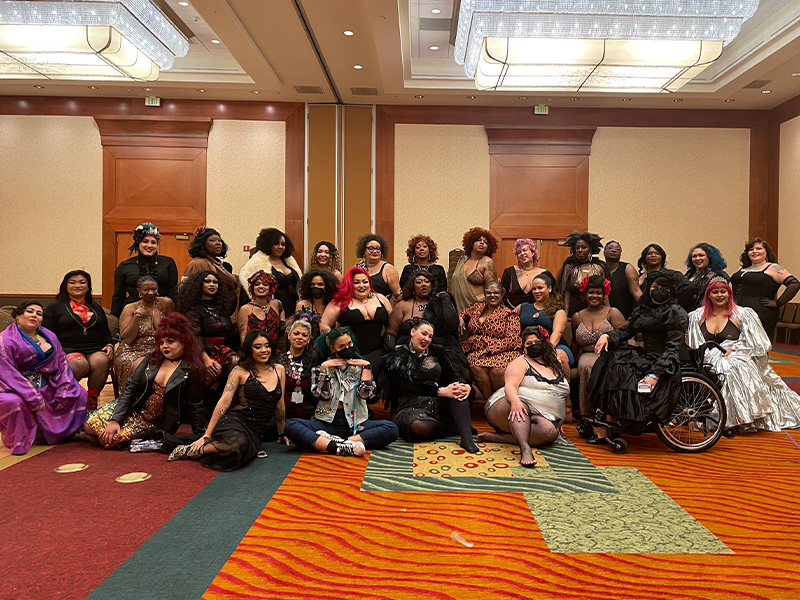
“BurlyCon is an annual burlesque educational convention that provides opportunities for skill-building, professional growth and social networking for the burlesque and cabaret community,” says Bea Lissima, a Filipinx-Italian queer femme burlesque dancer working in Mohkinsstsis (Calgary).
“Breaking down barriers for racialized burlesque dancers and advocating for the rights of sex workers has been an important part of building up our community in Calgary and in North America in general. Over the past few pandemic years, I’ve been working to create more opportunity for relationship building and education.”
Bea Lissima has been performing burlesque for the past 16 years and is an active member of Cabaret Calgary, a queer femme-led cabaret company. “When I first found Burlesque dancing, it was after high school, and I felt lost — I was looking for community. I was introduced to Demonika’s Symphony of Horrors, a cabaret variety show put on by Danika Challand, a Calgary fashion designer. There was a call for volunteer performers and a friend suggested we try out. I had no idea what burlesque was, but I immediately loved it — I felt like I belonged. I dove into learning as much as I could about burlesque and its history: books, documentaries, workshops, lessons — everything and anything I could get my hands on — I joined a troupe and eventually ended up getting involved with Cabaret Calgary four years ago.”
“Without funding through Calgary Arts Development’s (CADA) artist microgrant program, I wouldn’t have been able to afford to attend BurlyCon 2022. There were a few reasons why it felt important for me to attend,” explains Bea. “Coming out of the pandemic, I wanted to learn more about how I could elevate the community we are serving in Calgary, but also, I wanted to challenge myself as an artist, grow and develop my stage presence and abilities as a performer.”
Also, part of the draw for Bea was BurlyCon’s Legend program, which featured Shawna the Black Venus, an iconic burlesque performer in the ’70s and ’80s. “I wanted to hear about her journey as a Black woman performer — fighting euro-centric beauty standards and fighting for equal pay, compared to what white, cis dancers were being paid. Still challenges that are faced by equity-seeking artists working in burlesque and drag.”
“It was so beautiful to find a community within the diaspora in burlesque and from around the globe. I was able to meet other Filipinx artists, and we shared our experience of being Filipinx, queer, and being working artists who showcase their bodies in ways that weren’t part of our cultural upbringing — we were able to understand and support each other in a unique way.”
Bea’s already incorporated learnings from BurlyCon into programming with Cabaret Calgary. “We’ve been helping to create equity and stronger networks of support, especially for racialized artists, through free classes, one-on-one mentorships and reduced-rate studio space rental at our downtown studio. I’ve also helped create new performance opportunities with Melanin Monarchy, a collective of racialized drag and burlesque artists performing together. Being at BurlyCon renewed my spirit and has given me the energy to keep finding new ways to support and advocate for the community that has supported me.”
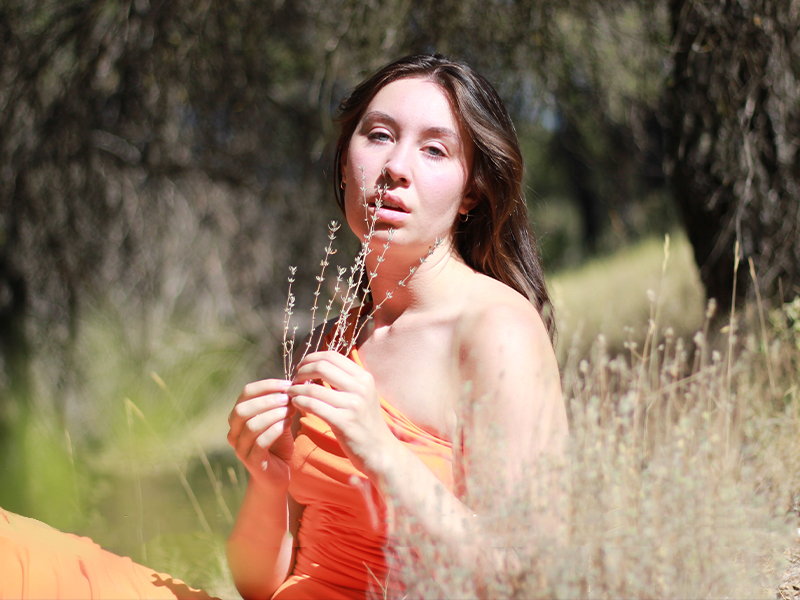
“The importance of space and time for artistic process is often taken for granted, which is why Calgary Arts Development (CADA) funding is so important for artists,” according to Marina Buston, co-founder of Lo-fi Spectacle Club.
Over the course of the last few years, Marina began journaling as a way of managing her grief over the breakup of an important relationship while coping with the ongoing loss of her father to dementia. “It’s an archive of heartbreak — a deeply personal journal of sorts. A way of processing my thoughts and experience moving through relationships, sexuality, desire and queerness — all within the context of grief — rooted in the loss of two different relationships.”
Marina shared her writing with her collaborator and co-founder of Lo-fi Spectacle Club, Hannah Meyers, who saw potential in pairing the written text with visuals. The combination of the two mediums gave the images a meme-like quality, while holding true to the depth and wisdom behind Marina’s experiences.
In 2022, Marina and Hannah received an artistic development microgrant from CADA to attend an arts residency, Joya: arte + ecologia, located in Andalucía, Spain. Joya offered Marina and Hannah time and space away from day-to-day life and the chance to live with an international community of artists, in an environment designed for sharing, learning and creative possibility. Having this time and space allowed their project to expand and further develop with the added dimension of global perspective. Marina and Hannah were able to experiment with creating a visual narrative with photos and videos overlaid with Marina’s writing.
“After living with the intense pandemic-related isolation of 2020 and 2021, I found it exhilarating to expose myself in such a vulnerable way to strangers,” says Marina. Initially, when Hannah and Marina first began working with each other on medicine cabinet, they both felt an interesting tension develop: “It was a liberating experience to have Hannah working with my writing — by having her inhabit the text by becoming the main subject in the images we were making. This coming together of text and visual that simultaneously represented both of our queer femme perspectives and universal truth was an interesting juxtaposition of intense specificity and the individual experience. And we felt drawn to exploring this relationship while at Joya.”
Both Marina and Hannah believe the funding to attend the residency and begin the process of creating this work together was crucial to how their work continues to develop and how it will eventually exist in the world. Marina believes, “this type of funding is essential to artists being able to start something, especially during these times when it’s challenging, especially for emerging artists, to get their projects off the ground and keep the momentum needed to bring them to completion — however that looks. These microgrant opportunities make it possible for emerging artists to find the space to develop micro-ideas into art that contribute to the ethos of Calgary’s art scene, but also into global conversations about art and human experience.”
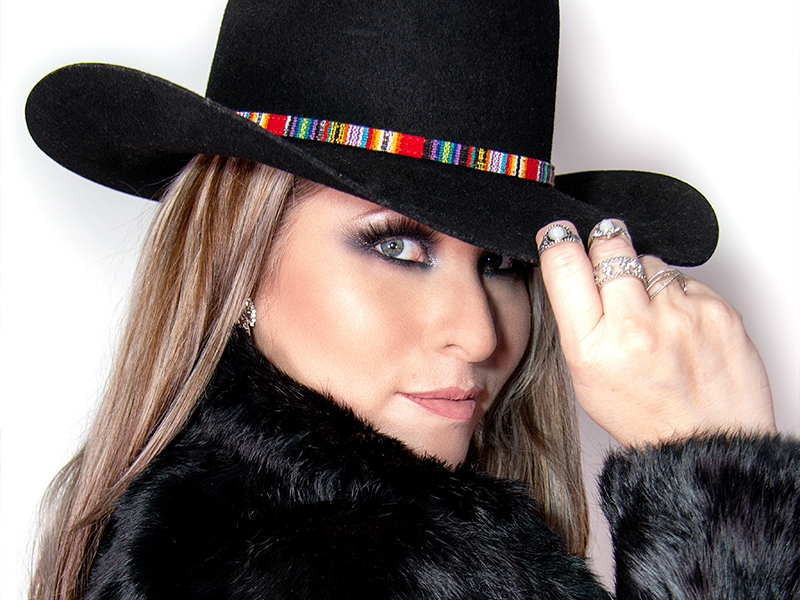
Paloma Negra came to Calgary in September of 2018 from Aguascalientes, Mexico and is quite possibly the only professional regional Mexican performer in Alberta. She sings and composes in several different regional Mexican styles including banda, norteño banda, ranchera, cumbia, country blues, rock and pop.
“Being a female songwriter in Mexico isn’t easy. As an emerging songwriter, it can be hard to find an established singer willing to take a chance on an unknown. When I arrived in Calgary, I decided that I was going to try singing my own songs.” Since she moved to Canada, Paloma has been nominated for Latin Awards Canada, and CBC Music’s Toyota Searchlight. She has toured across the country, performing in Ottawa, Gatineau, Montreal and Vancouver, and has collaborated with Harley Davidson, for her La Aventurera music video, and created jingles for various companies.
Mi Viejita Chula (My Lovely Old Lady), was written about 10 years ago as a tribute to Paloma’s grandmother, who raised her, but it’s also a tribute to all the aunts, grandmothers and adoptive mothers (blood-related or not), who raise other people’s children as their own: “These are people who recognize the value of these children and give them the affection and love that everyone deserves and needs — this was my grandmother; she gave me the strength and courage to live my dream.”
Paloma and her manager, Fredy Rivas, both felt that the story of Mi Viejita Chula would make a great music video and they were right. The video currently has more than 29,000 views on YouTube. Paloma credits Rivas with suggesting she work with an animator on the video. Funding from Calgary Arts Development’s (CADA) ArtShare program allowed Paloma to hire and work with Quiriam Pinilla, a professional animator based in England, who brought the memories of Paloma’s grandmother to life. “Pinilla’s animations captured the essence of my grandmother, down to the smallest detail. The clothes are identical to what she wore in real life! And most importantly Pinilla’s animation expresses the tenderness and the love that is at the heart of my song.”
“The funding from CADA is helping me build and grow my audience in Alberta and to grow as a performer.” Paloma appreciates how English-speaking Canadians and Albertans have embraced her music. “I feel like it resonates with a lot of Canadians who grew up listening to a lot of country music genres.” She also believes in the power of music as a universal language and its ability to introduce people to different genres of music that expand their world. “Making this music video has helped make my music more accessible for English speaking audiences. But also, has strengthened my connection with my Latinx audiences in Canada and Alberta; it reminds them of home and the regional music that they grew up with or that their parents or grandparents listened to. It brings together the strong emotions and connections of family and gives people the strength to keep going and to follow their dreams.”
YouTube video for Mi Viejita Chula.
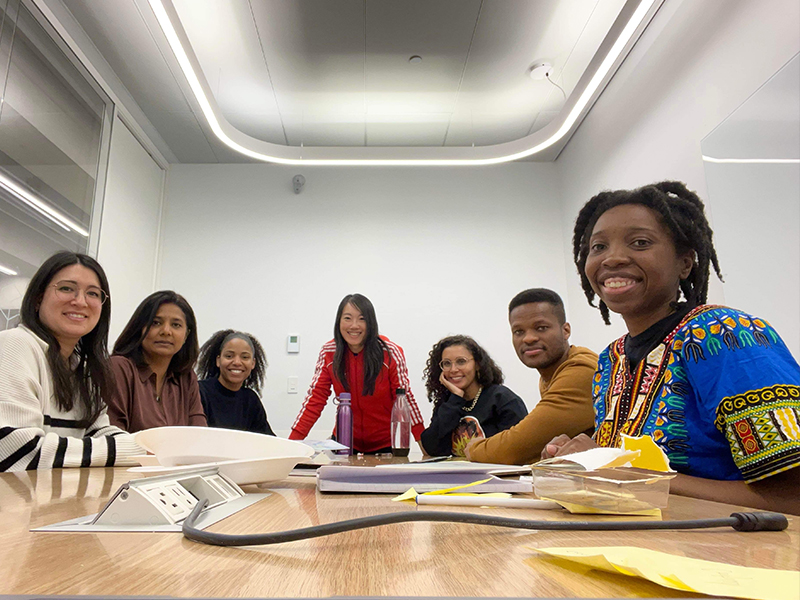
Diane Din Ebongue — Cameroon-born and France-raised — is curious about colours, specifically the colour of our skin and how that impacts us emotionally and socially. Her current project, I See Colours, is a mixed media project that uses film, photography and light to explore ethno-cultural diversity.
While a student of film, she often noticed unease in conversations around skin tone and the rendering of skin tone in film: “I began asking questions like, why am I perceiving myself the way I am? And why do people perceive me in a certain way? These questions led me to investigate the notion of perception — to bring ease into these conversations and to approach them from a multicultural perspective. I became interested in Johannes Itten’s colour theories, including his theory of colour contrast and his theory of colour harmony. Itten was a Swiss painter, but also part of the Bauhaus movement (1919-1933). He taught at the Staatliches Bauhaus in Weimar (Germany).”
Diane envisions three installations within the exhibit: an experimental video showing people of 16 different cultural backgrounds — all residents of Calgary — sharing their stories about ethno-cultural experiences. The emotional expression of all these faces will be made into one composite image, showing the unique yet simultaneous universality of human connection and emotions. The second instalment will be extracted portraits from the video, featured in a triptych-styled format, accompanied by painted swatches of colour, trying to match the skin colour in the portrait, and word art using different common keywords taken from the video. The final installation features two light boxes — one will invite people to observe un-animated 3D printed objects under the illumination of a light box with prompts to help people get curious about their perspectives. A second light box will have different tinted transparencies and people will be invited to look at their skin in a new light and colour, and reflect on how that makes them feel.
For Diane, digging deeper into this conversation is not just about art, “it’s personal. It’s about my experiences — how I’m treated as a person in the world — how I treat other people and the questions that I’m asked as a Black woman, and how our first encounters are connected to the colour of our skin. It’s also about sharing these experiences and starting a conversation about ethno-cultural differences without using the big R word — racism — a word that carries a lot of different context and subtext for people.
“When I first started developing this project in 2014, I didn’t have the funding to produce it. The ArtShare funding from Calgary Arts Development (CADA) has been essential in allowing me the time and space to research and begin production on the installation. And it’s also helped open many doors and opportunities for me, within the local arts community. I also appreciated the added level of support offered by CADA’s grant coordinator. As a new Calgarian and Canadian resident, and not being overly familiar with the process, their added support was welcome and appreciated.”
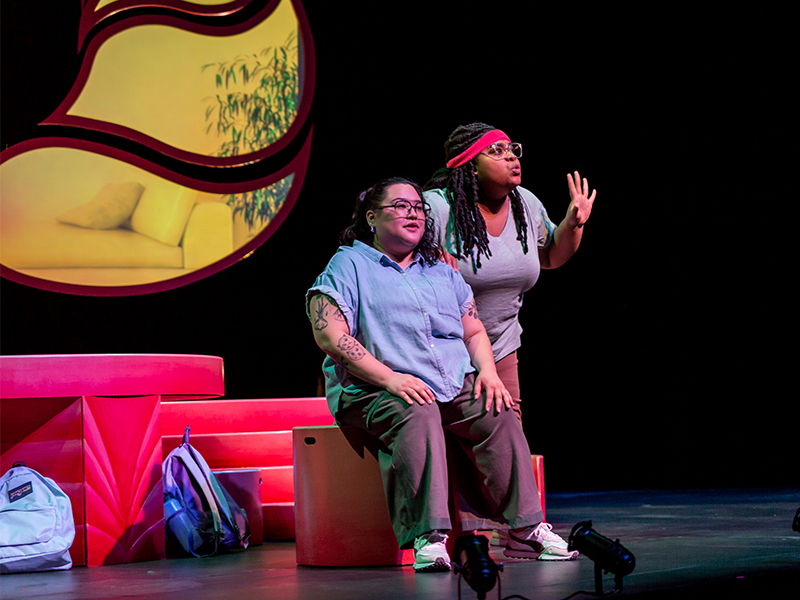
“The journey that we go through in this show is one we went through together,” explains Keshia Cheesman, a Caribbean-Canadian creator, educator and performer, and Bianca Miranda, a queer, Filipino performer, playwright and producer (born and raised in the Philippines). Together, these two multidisciplinary artists, based in Mohkinsstsis (Calgary), are working to change the way fat folks are perceived and how they perceive themselves.
“Five-and-a-half years ago, we had a dream to create and perform a show together — one that we connected to, that represented our communities, and that we could fully bring ourselves to. This show is that dream coming to fruition.”
“The world premiere of The F Word has been a goal we have been working toward since we graduated university.” Bianca and Keshia integrate many different modes of storytelling to transport audiences along on their journey. “We use songs, movement, fairy tales, talk shows, lectures and more, while exploring our friendship as two fat women on a journey to self-acceptance and fat liberation. We confront fatphobia, diet culture and the intersection of fatness with race in this powerful, playfully political pop-art piece. This show was inspired by our personal lives.”
A Downstage production, presented by Alberta Theatre Projects in association with Handsome Alice & Theatre Calgary, Bianca and Keshia not only co-created and co-performed, they also co-produced The F Word: “Funding from Calgary Arts Development (CADA) was used to support us as producing partners for the world premiere. With this, we were able to, first and foremost, pay ourselves accordingly. It also allowed us to advocate for size-accessible seats as part of the Martha Cohen Theatre. Size-accessible seating was an important goal towards making sure fat folks felt accepted and respected in a theatre space. Being producing partners also meant that we attended a lot of meetings, consultations, and offered feedback for marketing and communication assets. It was really important to us that we had a say in different parts of the production and made sure our storytelling extended beyond the stage.”
With the funding from CADA, Keshia and Bianca were able to fully invest their time, energy and emotional labour as playwrights, performers and producing partners: “The impact of this funding for us is huge. We were able to show up fully without worrying about proper compensation and make sure our basic needs were met throughout the process — a reassurance that as artists, we deserve pay at every step of the way in our art-making.”
“We believe this show has a life beyond this world premiere as there is a strong need in our society to give visibility to fat folks and to bring awareness to the harms of anti-fatness in our world. Based on audience feedback, people from all lived experiences were able to reflect, learn and celebrate the topics discussed in The F Word. As artists who are fat women of colour, we have always wanted to make art that allows folks from our marginalized identities to feel seen and we are proud to have a small part in demanding a better future for fellow fat folks through our art.”
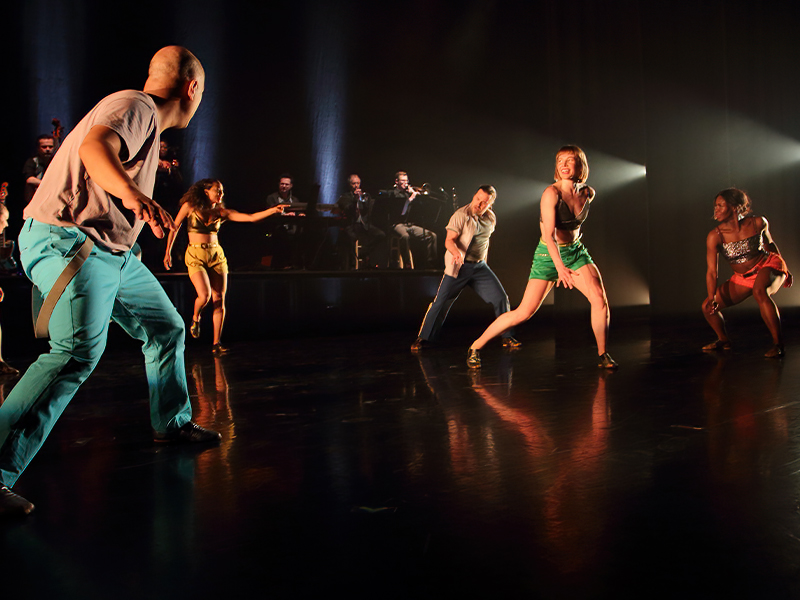
Over the last 39 years Decidedly Jazz Danceworks’ (DJD) reputation as a professional jazz dance company has grown locally, nationally and internationally in the dance community. Primarily known as a jazz dance company, they also run Calgary’s largest recreational dance school with thousands of participants of all ages and abilities taking classes in a variety of genres.
Their newly renovated building, architecturally designed with dance in mind, is a growing community hub for many different dance groups and individual artists in Calgary. They also offer training for aspiring professional jazz dancers, outreach for inner-city schools, educational programming, and a dance program for people living with Parkinson’s.
Every year, DJD relies on operating grants to support its dance programs and performances year-round. As part of the 2022 operating grant received from Calgary Arts Development (CADA), DJD was able to run three important programs that helped the company continue to develop artistically and connect with audiences despite the disruption of the pandemic.
Dance on Film offered opportunities for dancers to continue working through and coming out of the pandemic: “Working with film was transformative,” explains Artistic Director Kim Cooper. “There are things you can do in film that you can’t do onstage, allowing our dancers to play and use their imagination. Working with film also exposes new audiences to our work through platforms like the Calgary International Film Festival and other international dance film festivals.”
DJD’s Dance Drive-in offers audiences a fun alternative to a traditional cinematic drive-in and equally dramatic! “Our uniquely designed performance space, the breezeway, features a floor-to-ceiling, glass façade that allows us to put on performances that people can watch from the outside. Or in this case, from the comfort of their car,” says Cooper.
Also, in 2022, DJD presented its first onstage, public performance since the start of the pandemic — a celebratory piece called Family of Jazz. “We invited guest choreographers Brandi Coleman, Melanie George and Lisa Latouche to join me in creating a new show filled with energy and joy to welcome audiences back into our theatre for live performances. The show featured a seven-piece jazz ensemble comprised of Albertan musicians including vocalist Karimah. It was an exciting moment for everyone to be performing live onstage, again. Unfortunately, we were forced to close the show early due to COVID outbreaks.”
Funding from granting organizations like CADA has made it possible to keep programs running and to support dancers and staff through the pandemic. Kim Cooper feels strongly that the seeds they were able to plant over the past few years are now paying off: “We’ve been invited to one of the most prestigious dance festivals in North America, Jacob’s Pillow, and we’re also in negotiations with the National Arts Centre (Ottawa) and Festival Arts Saint Sauveur (Quebec) as part of our commitment to invest in national touring. Being adaptable and continuing to explore, create and share our work has allowed us to keep imagining the possibilities. Dance on Film and Family of Jazz are two incredible examples of how we’ve been able to raise our profile internationally — despite the challenging pandemic years.”
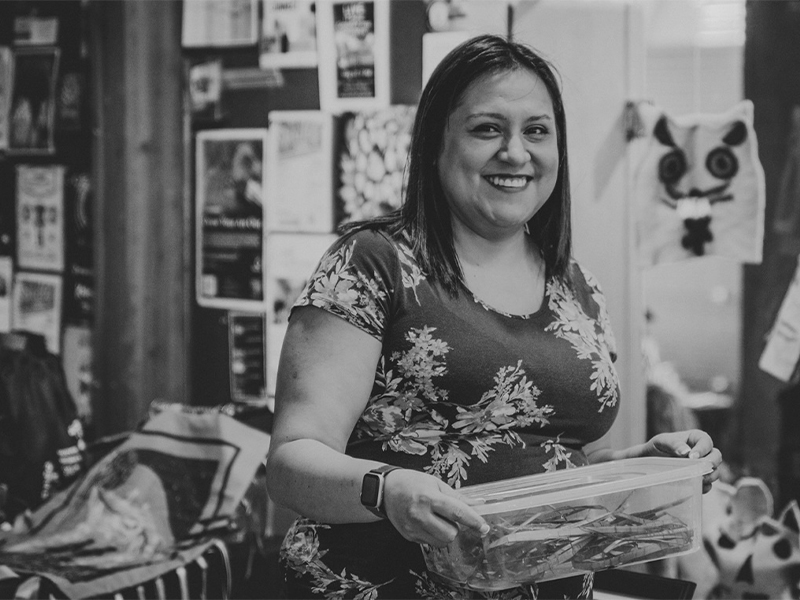
Originally from the Stó:lō reserve near Rosedale, outside of Chilliwack, B.C., Melissa Victor moved to Calgary 15 years ago to have more access to support for her and her oldest son, who has autism. “I’ve been a jewelry maker since 2018, mostly beaded jewelry, but over the past couple of years I noticed a feeling of wanting to reconnect with my culture and learn the traditional ways of harvesting cedar and cedar weaving.
“I want to be able to pass this traditional knowledge and art form on to my children, so they can also feel connected to their Indigenous roots. I also want to be able to share my knowledge with my community in Calgary.” Receiving funding through the Indigenous microgrant program offered by Calgary Arts Development gave Melisssa the opportunity to reconnect with knowledge keepers and traditional ways of her Stó:lō community.
“In August I travelled to visit the reserve in Rosedale to learn cedar harvesting and weaving from Crystal Chapman. My goal was to learn how to weave a traditional Stó:lō cedar hat and also to weave 13 pairs of cedar shoes with the cedar I would harvest. The cedar shoes are a healing medicine and a memorial for the lives and spirits of the children who died in the residential school system and will help their spirits heal as they travel in the spirit world.”
As Melissa embarked on this journey, she initially felt nervous: “For the entire drive to Rosedale, I was feeling a lot of anxiety around whether this was what I should be doing. I was nervous about making mistakes and about feeling like I didn’t belong. As I was driving, I became aware of the smell of sage, and noticed it for the entire drive. I realized it was a sign that I was moving in the right direction, and it gave me the courage to keep going and not turn around.”
With a portion of the funding from Calgary Arts Development, Melissa was able to participate as an artist in the Indigenous Resilience Festival in Kelowna, B.C. “I was able to share my story and my learnings through the traditional art of oral storytelling and weaving. Being able to gather with over 40 Indigenous speakers and artists to hear their voices and inspiring stories was powerful. To learn from and reconnect with my community was an important experience for me.”
Melissa feels that working with cedar has expanded her artistry as a jewelry maker and a beader. “The whole experience has helped me grow as an artist, but also as a mother, in being able to share this traditional knowledge with my children and also finding ways to incorporate cedar into the jewelry I make.”
Melissa also feels strongly about the importance of having funding specifically for Indigenous artists that allows them time and space to create, learn and share. “There’s a lot of healing that needs to be done and for me, cedar is my medicine — being able to reconnect with it and my community is the path to build stronger communities of Indigenous artists across the land and to strengthen the communities in which we live.”
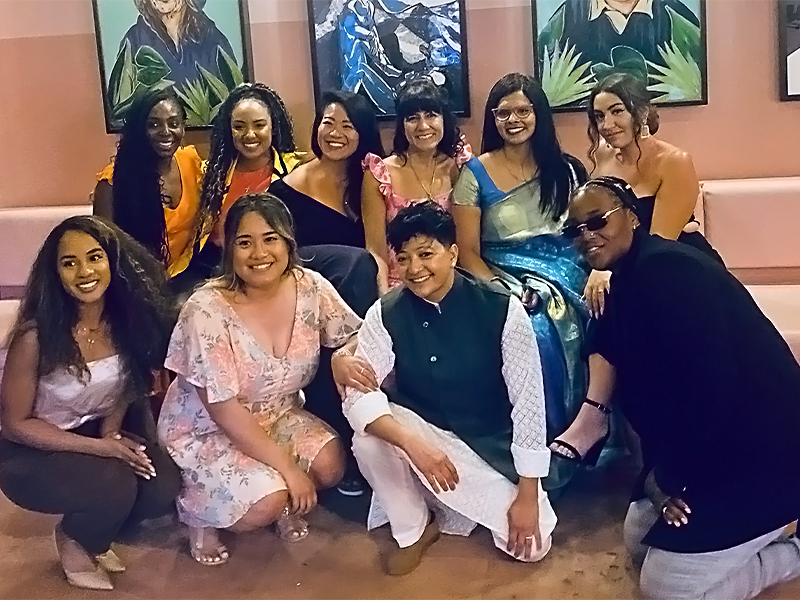
Humainologie has been creating award-winning short films since 2016. In Fall 2022, with the help of both operating and project funding from Calgary Arts Development (CADA), Humainologie launched and produced a series called SHADES: Amplify Her Voice, a storytelling project made up of 15 short films (ranging between 60-90 seconds in length) that highlight the lives of five different Calgarians who are Black women and women of the Global Majority. The series premiered at the Black woman-owned Plaza Theatre with a red-carpet entry by three of the film stars.
Without overlooking or ignoring the systemic disadvantages and challenges experienced by Black and racialized women, the SHADES films, which have now received over 70,000 views online, celebrate the identities, uniqueness, contributions and humanity of the Calgary women they profile.
“The artists and communities we serve hold identities and stories that have been historically excluded or misrepresented,” says Humainologie’s Ciermae Allen (Community + Events). “Our mission is to centre people facing systemic barriers by amplifying their stories and celebrating their humanity. CADA’s funding allows us to provide a platform where people who have experienced systemic barriers are the main characters.”
“As a Ghanaian woman who was born and grew up across Alberta, these stories made me feel more seen, recognized and celebrated in public spaces than ever before,” said Hawa Kombian, an attendee at the SHADES premiere.
“The SHADES project is an example of radically centring people,” says Humainologie’s Salima Stanley-Bhanji (CEO), “not only through the storytelling process, but also via a platform of support we offer to each of our cast members.”
One example of the support provided to SHADES cast members is the current collaboration between Humainologie and Calgary rap and funk artist Sinzere, to produce a music video for her Tabula Rasa album. “Providing both financial and in-kind support allows us to empower people wherever they are in their journeys: creatively, professionally and personally,” says Allen. Funding for mental health support is also being provided to the cast of SHADES season 2, which will premiere in early 2024.
“I am excited to see Humainologie and SHADES delve into such authentic, holistic and rich stories of our melanated sisterhood and continue this incredible momentum,” shared Kombian, who sees the potential for the project to expand into other cities.
“Thank YOU…for seeing something in me, to want to help tell a part of my story,” shared one of the SHADES cast. “For connecting me to so many other amazing people. For REALLLLLLLLYY loving us up. For such an amazing evening I’ll cherish forever. I’m honoured. I’m touched. I’m so full and grateful.”
Humainologie runs an annual short story festival which has awarded and profiled Black, racialized, queer, disabled and immigrant women writers. Collaborating with TEDx YYC, Humainologie supports speakers and coaches from communities that experience systemic barriers. The organization is also developing an Indigenous Bursary Program for Indigenous post-secondary students with $500,000 in endowment funds already committed.
Humainologie’s vision is an equitable world where every human is heard, included and valued.
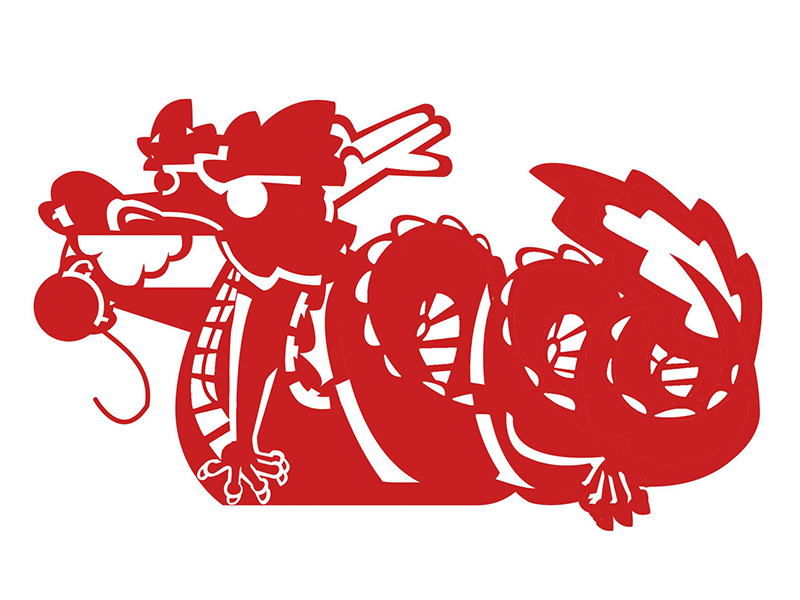
“Calgary’s Chinatown is our favourite,” according to husband-and-wife artist duo Kevin Chow and Jamie Mason. “We love it! And we’re always looking for ways we can connect with the community and contribute to its vibrancy.”
Kevin and Jamie applied for Calgary Arts Development (CADA) funding with the intention of working with the Calgary Chinese Cultural Centre to help them with building a bank of contemporary art rooted in Chinese culture. “We felt a connection between our pop art minimalist style to create young, modern, unique digital art, based on the traditional images of the Chinese Zodiac. We created images in what we call a paper cut-out style which adds dimension and lends a playful, whimsical energy to the pieces. We wanted to create art for the Centre that reflected their vibrancy and appeal to a younger demographic, new members of the community, and of course be social media friendly.”
Part of the project Kevin and Jamie worked on also included a sculpture of one of the most recognizable creatures of the Chinese zodiac — the dragon. A mixed media sculpture, the dragon is about 5 feet long and 4 feet high. The sculpture is built in two pieces — because it is so long, being able to dismantle it into two sections makes it easier to display and transport. The dragon is done in their signature style but is also illuminated — Kevin and Jamie call their illuminated sculptures night-lights. “They kind of look like those night lights we had as kids — they’re a little cartoon-y with bright colours. For this sculpture we used Lexan, LEDs, wood and vinyl. We try to use up-cycled materials when possible,” explains Kevin.
According to Jamie, they first started making this illuminated style of sculpture in 2021. “The first sculptures we made were of various Chinese fruits and vegetables. We received funding from the regional municipality of Wood Buffalo and the finished sculptures were part of the Ignight: Art Illuminated festival. We also took some time at Fuse 33 Makerspace to work on production.
Kevin and Jamie feel this project happened at an auspicious time — the City of Calgary has released an initiative called Tomorrow’s Chinatown, a first-of-its-kind program in Calgary consisting of three community-informed projects that will help the community move forward into the future. “We feel that these original digital art works offer a way to reimagine tradition. Beyond the familiar, but familiar at the same time,” says Kevin. “Reimagining the image gives way for new interpretations — the outward facing package, so to speak, is new and different but stories and symbolism rooted in the traditional image are still there.”
“The funding offered by CADA to artists like us is important, because it is often a challenge for individual artists to unlock private sector funding and without funding many projects would never come to fruition,” says Jamie. “Funding like this also helps artists and communities create together. Kevin and I come from the mindset that when it comes to community art it should be collaborative, not prescriptive.”
“And,” adds Kevin, “these community-based art projects are like stepping stones to future projects, collaborations, and relationships that create more connectedness, vibrancy, and energizes communities, which in turn draws people in and creates more opportunities for engagement.”
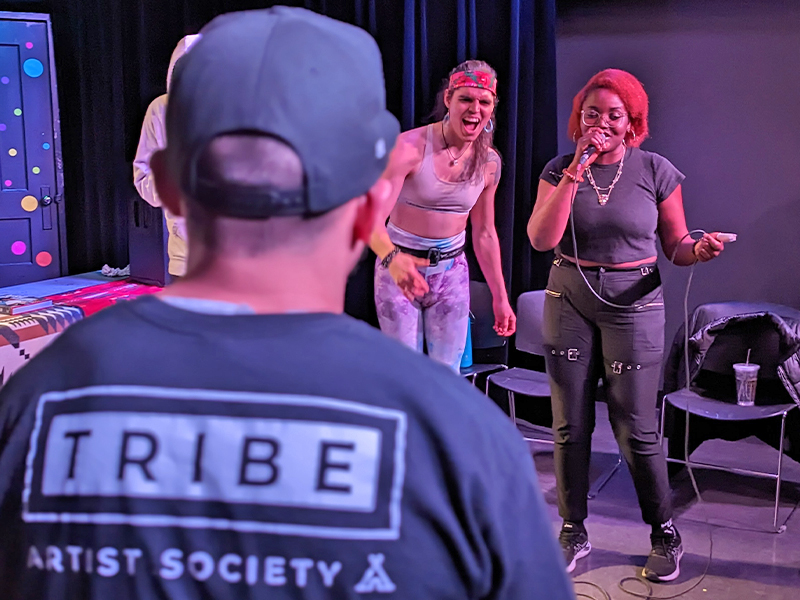
“We help artists become their most powerful selves. Tribe Artist Society (TAS) is an Indigenous-led, hip hop and arts agency where all folk are welcome to participate in culture, create and be loud — whether that’s vocal, musically or using Instruments.”
Dwight Good Eagle Farahat is an artist, rapper, poet, songwriter, arts facilitator and social worker and most recently the Executive Director of TAS. “The power of creating spaces like this isn’t just in the great art it produces. Our goal is to create a space where folks can have fun and create, but at the heart of it, we’re building community. One of the ways we measure the success of our community building is by asking our artists, ‘Do you now have at least five people from our community you can talk to about problems you have?’ ‘Do you feel like you belong to a community?’”
Farahat has long acknowledged that the needs for Indigenous arts spaces are different from non-Indigenous art spaces: “We need arts spaces that are run for us and by us. I don’t think there are any Indigenous-led public creation spaces in Calgary. Ceremony is also a part of our space. For example, our Monday night rap group begins with a feast, we smudge, and then we move into cyphering and jamming.”
“Calgary Arts Development (CADA) has been a huge support and believer in what we’re trying to create. It’s important for this space to thrive. CADA has shown us that they’re invested in TAS, and in helping us build a solid foundation with the funding we’ve received through the Original Peoples Investment Program (OPIP). CADA has helped us set the foundation to become a strong Indigenous organization. TAS is a young organization. And CADA understands that we’re still learning and building — for about six months TAS was funded by me and my family — so to have this financial support and a local granting body like CADA believe in us and want to see us succeed means a lot.”
Right now, TAS doesn’t have an office or permanent home. But they still have a presence in the communities they’re working with. “We’ve been working with the Calgary Young Offenders Centre, Forest Lawn High School, Arts Commons, and are hoping to be in a university in September. Our Lunchtime Rap program at Forest Lawn is an example of a program that’s for all students interested in learning how to rap and cypher — it’s a chance to come together and connect. We’ve also been working with the Indigenous Learning Lodge (ILL) at Forest Lawn, which offers additional programs and levels of support for Indigenous students.”
The ILL has been working with Dwight and Elders Leroy Little Bear and Leroy’s wife Amethyst First Rider. They recently took the students on a field trip: “They’re learning from Elders about their land, their history and the Buffalo Treaty and how the return of the buffalo is important to this land. Learning with our Elders is an important part of our culture. We need our knowledge keepers in these spaces too.”
Dwight sees continuing to build a solid foundation and gaining a better understanding of the funding landscapes in Alberta and Calgary as essential to TAS’s future: “We’ve learnt so much over the last two years and are still learning. We want to develop in a good way. Continuing forward with baby steps. We are gaining the right tools to hunt with, so we can have a healthy tribe and survive. This way we can leave TAS for future generations to build on and help the people.”
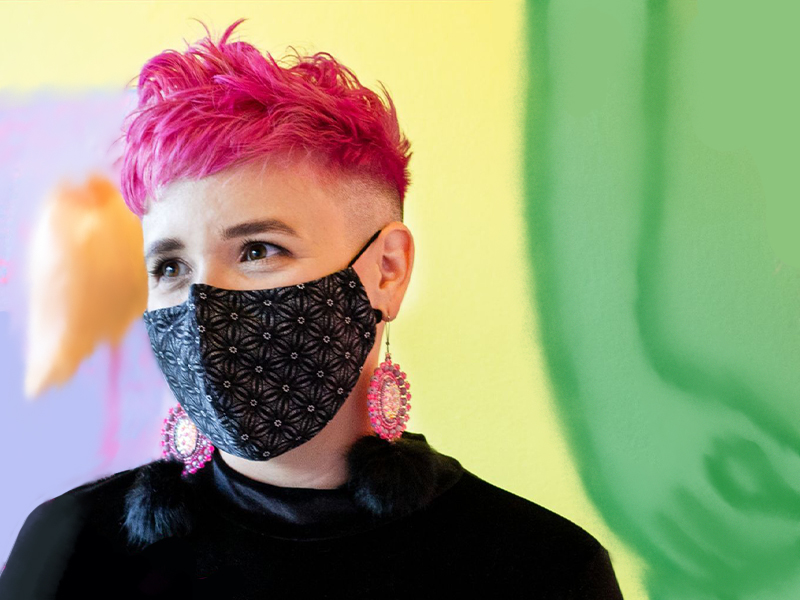
“As a trans nonbinary artist, I explore themes of identity, gender, the body and evolution through immersive exhibitions,” explains Ash Adams. “I recently received a grant from Calgary Arts Development (CADA) to develop and present my solo exhibition Lace + Leghair: A Euphoric Exploration of Gender Outside the Binary, where I created artworks about my transition. Lace + Leghair explores thoughts and conversations surrounding transitioning, growth, change, choices and mortality through the lens of euphoria and humour. In the process of creating Lace + Leghair I realized I’m ready to take my art to the next level.”
Adams graduated from the Alberta College of Art + Design in 2018, with a BFA majoring in ceramics. They are currently based in Mohkinsstsis (Calgary) and are an educator and advocate for 2SLGBTQIA+ rights and artists with disabilities. They are also a co-founder of Superbloom Collective, a collective that focuses on “creating empathetic and connective artworks and pedagogies through public art, mural work, and the facilitation of workshops.” And one of 10 artists that make up the Basic Income Calgary Arts Collective, which advocates for the Artists with Disabilities (AWD) community.
Much of their recent work expresses ideas around choices and mortality as well as identity and the body. Adams describes Lace + Leghair as an immersive exhibition “I explore concepts of gender through acrylic paintings, mixed media sculptural tableaux and murals. I use my expertise in ceramics to cast parts of my body to manipulate ideas and tell stories. I want my work to overwhelm and hypnotize the viewer. I work with re-rendered collage as a primary subject matter and using acrylic paints, arrange objects on explosive coloured backgrounds. The backgrounds create an optical illusion, and manipulating my references allows me to influence the narrative.”
Adams worked with a team of other artists and creators to help them realize their vision for Lace + Leghair: “A team of other artists and creators came together to help me realize my creative vision. We collaborated on artworks including the complex task of life casting my own breasts, later used in a sculptural tableau. Five friends gathered in my kitchen to painstakingly plaster, cast and form the pieces as I had to hold still in an uncomfortable position for over an hour. We documented the ongoing artistic process with live polaroids. These polaroids were then displayed on a wall in the Lace + Leghair exhibition to show people the behind-the-scenes work required to create the show. This ended up being a popular installation because people like to see the inner workings of the creative process.”
“Funding opportunities like the Individual Project Grant benefit me as an artist by allowing me to dedicate time to my practice and create meaningful works of art. I intend to continue my exploration of immersive gallery spaces through detailed works and removable wall coverings, allowing me to integrate the surfaces of the gallery into the installation. And inviting the audience to fully immerse themselves in the colourful, stimulating, vibrating experience.”
